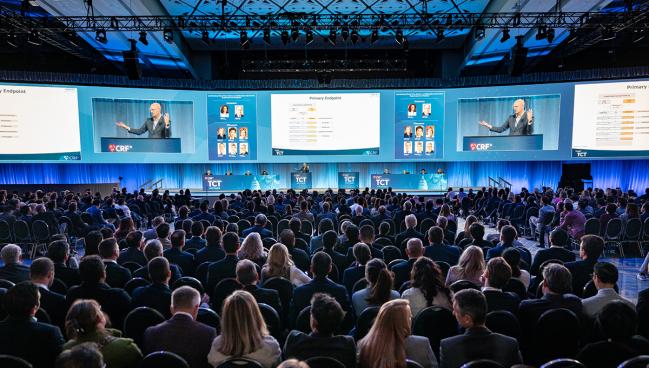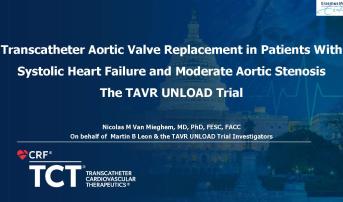TAVR UNLOAD: No Rush to Do TAVI in HFrEF Patients With Moderate AS
(UPDATED) Select patients with moderate AS may benefit, but in general it’s okay to wait for severe stenosis, Nicolas Van Mieghem says.

WASHINGTON, DC—For patients who have heart failure with reduced ejection fraction (HFrEF) accompanied by moderate aortic stenosis (AS), there’s not much to gain by doing TAVI before the valve disease becomes severe, the TAVR UNLOAD trial indicates.
Though the procedure was safe, performing TAVI initially did not provide a significant clinical benefit over watching the patient and performing aortic valve replacement only upon progression to severe AS, Nicolas Van Mieghem, MD, PhD (Erasmus University Medical Center, Rotterdam, the Netherlands), reported here at TCT 2024.
Gains in quality of life assessed using the Kansas City Cardiomyopathy Questionnaire (KCCQ) favored immediate TAVI through 1 year, but the advantage dissipated as more and more patients in the control arm progressed to severe AS and underwent the procedure.
Based on the results, which were published simultaneously online in the Journal of the American College of Cardiology, if physicians follow guideline recommendations for TAVI and wait to replace the valve until AS is severe, “you have nothing to lose” because there were no improvements in survival or other hard clinical endpoints, Van Mieghem told TCTMD, noting that these findings apply only to patients with HFrEF.
“We should not change the current guidelines. I think it is worthwhile to wait for moderate aortic stenosis to become severe in symptomatic heart failure patients before you expose these patients to a TAVR,” he stated. “That said, in patients who have recurring symptoms that are difficult to control medically, those might be good candidates for a preemptive TAVR. So it’s a selected group of patients.”
Amar Krishnaswamy, MD (Cleveland Clinic, OH), who was not involved in the trial, said that when confronted by a patient with HFrEF who is considered to have moderate AS based on an echocardiogram, the first step a clinician should make is to confirm that the stenosis is, in fact, moderate and not severe, possibly with a dobutamine stress echo or CT scan. Then, a heart failure specialist should ensure that guideline-directed medical therapy (GDMT) for that condition is optimized.
“And if, ultimately, once the medicines are optimized, moderate AS is confirmed and the patient remains symptomatic, then there perhaps could be a role for the use of TAVR,” Krishnaswamy commented to TCTMD. He added, however, that reimbursement for the procedures may be a challenge in the absence of approval for the treatment of moderate stenosis.
Serving as the discussant following Van Mieghem’s presentation, HF specialist JoAnn Lindenfeld, MD (Vanderbilt University Medical Center, Nashville, TN), said TAVR UNLOAD, though it has limitations, may change practice.
“It's going to give me data to ask my interventional colleagues to proceed earlier because the procedure is safe, and there's no downstream safety issues,” she said. “There was a huge rate of development of [severe] aortic stenosis. So patients will need careful follow-up, but these patients are frail, elderly. Frequent follow-up is difficult and costly. And if you can get your average 77-year-old patient to do a dobutamine stress test, you're a better physician than I am. They hate the dobutamine stress test.
“Just from a practical matter,” she continued, “I think that early [intervention] is going to be good for these patients to reduce afterload.”
Lindenfeld also suggested that the trial results may be enough to support a class IIb recommendation in guidelines, one that says “TAVR is indicated in selected patients with heart failure and reduced EF, and moderate AS, if patients have difficulty with frequent follow-up, can't do frequent follow up, which is required because so many get severe AS, and are limited in the uptitration of GDMT due to aortic stenosis.”
Testing TAVI to Reduce Afterload
A primary goal of drug treatment for heart failure is to reduce afterload, Van Mieghem said, adding that the idea for TAVR UNLOAD came from his observation that some of his patients with LV dysfunction also had moderate AS. The question then became: would the mechanical treatment of moderate aortic stenosis be complementary to GDMT for afterload reduction and improvement in clinical outcomes in HF?
To find out, Van Mieghem and his colleagues initiated the TAVR UNLOAD trial, which was conducted at 66 centers in the United States, the Netherlands, and Austria. The investigators enrolled patients with NYHA class II or worse heart failure who had been taking stable GDMT for at least 1 month, had an LVEF below 50%, had moderate AS confirmed by an echo core lab, and had anatomy suitable for transfemoral TAVI with a Sapien 3 or Sapien 3 Ultra transcatheter heart valve (Edwards Lifesciences).
The trial design was modified from a 600-patient target enrollment and a primary endpoint analysis at 1 year to half the enrollment target and a primary endpoint analysis at longest follow-up. But due to slow enrollment—at least partly related to competition from another trial in moderate AS (PROGRESS)—and funding constraints, the trial was stopped early after only 178 patients (mean age 77 years; 20.8% women) were randomized to TAVI or clinical AS surveillance, with valve replacement performed only when AS progressed to severe. At baseline, the mean STS score was 4.4% and mean LVEF was 39%. More than half of patients (55.6%) were in NYHA class III/IV.
We should not change the current guidelines. I think it is worthwhile to wait for moderate aortic stenosis to become severe in symptomatic heart failure patients before you expose these patients to a TAVR. Nicolas Van Mieghem
In the TAVI arm, the procedure was safe, with one case each of disabling stroke, BARC type 3 bleeding, acute HF-related hospitalization, acute kidney injury stage 2 or 3, and repeat procedure for bioprosthetic valve-related dysfunction in the first 30 days. In addition, four patients required a new pacemaker for high-degree atrioventricular block. There were no deaths, major vascular complications, or cases of new-onset atrial fibrillation or coronary artery obstruction requiring intervention in this early period.
In the surveillance arm, 43% of patients ultimately underwent TAVI at a median of 12 months after randomization—in all but three cases, this was due to progression to severe AS.
The primary endpoint, assessed at a median follow-up of 23 months, was a hierarchical composite of all-cause death, disabling stroke, disease-related hospitalizations and HF hospitalization equivalents, and change in KCCQ overall summary score from baseline. Though each component tended to favor immediate TAVI, the win ratio indicated no significant difference (win ratio 1.31; 95% CI 0.91-1.88).
Assessed at 1 year, however, TAVI had a higher proportion of wins versus surveillance (48% vs 31%), resulting in a significant advantage (win ratio 1.55; 95% CI 1.04-2.31).
Through longest follow-up, a secondary MACCE endpoint (all-cause death, stroke, disease-related hospitalizations, or HF hospitalization equivalents) occurred at a numerically lower rate in the TAVI arm, but the difference was not statistically significant (64.6% vs 80.5%; HR 0.83; 95% CI 0.56-1.24).
There was a greater increase in KCCQ overall summary score through 1 year with immediate TAVI than with surveillance (12.8 vs 3.2 points; P = 0.018), although scores had converged by 2 years and at longest follow-up (P = NS for both). At the end of follow-up, however, a higher proportion of patients had a KCCQ gain of at least 5 points if they received immediate TAVI versus surveillance (61.2% vs 43.2%; P = 0.024).
Other measures, including generic health status assessed by the 36-Item Short Form Health Survey, EuroQol index, 6-minute walk distance, NT-proBNP level, and B-type natriuretic peptide level, did not differ between trial arms.
Progression to Severe AS Faster Than Expected
Van Mieghem said the outcome of the trial was influenced by a rate of progression from moderate to severe AS in the surveillance arm that was more rapid than anticipated, resulting in a high rate of crossover. What that means is that, at least in the HFrEF population, patients with moderate AS should be followed more closely, he said, suggesting that the interval between echocardiograms should be shortened. “Then you can treat when it becomes severe without having the patients suffer too much with shortness of breath and decremental quality of life.”
He noted that because roughly one-fifth of the patients in the control arm required TAVI within a year, it’s likely they were “on the edge of becoming severe” at the start of the study. “And that also drives the study results,” said Van Mieghem.
Despite the limitations, however, the trial clearly shows that immediate TAVI did not reduce mortality or HF hospitalizations in this population. “What we need to do is try to identify the patients that might clinically benefit more from preemptive TAVR treatment,” he said. “Probably it might be the patients with asymptomatic severe AS and maybe it might be another patient phenotype with moderate aortic stenosis, but it’s not the HFrEF patient. I am convinced about that.”
This is a signal to caregivers that we must be more thorough in diagnosing the severity of AS in those patients who we think may only have moderate AS. Amar Krishnaswamy
Krishnaswamy said it’s hard to understand the lack of a significant impact on longer-term outcomes because the study was underpowered and there was a high rate of crossover. Considering that, the improvements in quality of life at 1 year in the TAVI arm “are something that at least tells us that we should be looking at this more closely,” especially since there was not a major risk associated with the procedure, he said.
In addition, the high rate of crossover due to progression to severe AS is somewhat surprising when considering prior data on the rate of progression in patients with moderate disease, he said.
“It does very much for me raise the concern whether what was called moderate AS was in fact severe. In my clinical practice, I’m often confronted by patients who have severe AS and were mislabeled as moderate AS either due to their depressed ejection fraction or some other low-flow state,” Krishnaswamy said. “And I think this is a signal to caregivers that we must be more thorough in diagnosing the severity of AS in those patients who we think may only have moderate AS.”
Taking a broader view, Krishnaswamy said the safety of TAVI “will allow us to evolve our practice as we move forward to treat patients who may be more vulnerable to their valve disease than we traditionally realized. And a lot of the work over the past 2 years that has gone into understanding the implications of aortic valve stenosis on cardiac damage and trying to reclassify how we look at the ramifications of valve disease on the heart has gone a long way in helping us understand that we’re probably treating many patients later than we should be.
“And so UNLOAD TAVR,” he continued, “is an important study that provides us more understanding along exactly these lines.”
An accompanying editorial led by Philippe Généreux, MD (Morristown Medical Center, NJ), who earlier in today’s session presented the EARLY TAVR results, notes that the potential role of TAVI in patients with moderate AS and preserved ejection fraction remains unknown, adding that two ongoing trials—PROGRESS and EXPAND II—will provide some clarity.
Todd Neale is the Associate News Editor for TCTMD and a Senior Medical Journalist. He got his start in journalism at …
Read Full BioSources
Van Mieghem NM, Elmariah S, Spitzer E, et al. Transcatheter aortic valve replacement in patients with systolic heart failure and moderate aortic stenosis: TAVR UNLOAD. J Am Coll Cardiol. 2024;Epub ahead of print.
Généreux P, Gupta A, Makkar RR. TAVR in patients with moderate aortic stenosis and heart failure. J Am Coll Cardiol. 2024;Epub ahead of print.
Disclosures
- TAVR UNLOAD was sponsored by the Cardiovascular Research Foundation and funded by an investigator-initiated grant from Edwards Lifesciences.
- Van Mieghem reports having received grant support from Abbott Vascular, Boston Scientific, Edwards Lifesciences, and Medtronic; and having received advisory fees from Abbott, Boston Scientific, Pulse Cath BV, and Medtronic.
- Généreux reports various relationships with Abbott Vascular, Edwards Lifesciences, iRhythm Technologies, Medtronic, OpSens Medical, Puzzle Medical, Pi-Cardia, SoundBite Medical Solutions, Teleflex, and 4C Medical.
- Krishnaswamy reports no relevant conflicts of interest.
- Lindenfeld reports receiving consulting fees/honoraria/speaking fees from Abbott, AstraZeneca, Edwards Lifesciences, Boston Scientific, Abiomed, CVRx, Alleviant Medical, Axon Therapies, Bayer AG, Medtronic, Merck/Schering-Plough, V-Wave, and Vascular Dynamics, as well as grant support/research contracts from AstraZeneca.







Comments